10 May 2013
In response to great demand, we have decided to publish on our site the long and extraordinary interviews that appeared in the print magazine from 2009 to 2011. Forty gripping conversations with the protagonists of contemporary art, design and architecture. Once a week, an appointment not to be missed. A real treat. Today it’s Giulio Iacchetti’s turn.
Klat #03, summer 2009-2010.
Thought and design are two inseparable entities in Giulio Iacchetti. His design vision expresses dissent and protest in a poetic way. He seeks and finds alternative, unprecedented, unthinkable viewpoints. Iacchetti is the importance of disobedience. More than a designer, he’s a critic, perhaps. He is undoubtedly a subtle observer, capable of grasping the deeper value of his trade. Which is not just a question of style: it is the desire for a beautiful form that can last in time, that can age together with the person who chose it. In 2009, the Triennale Design Museum of Milan, in collaboration with Mini, began a program of events on new Italian design starting precisely with Giulio Iacchetti, and the exhibition Oggetti disobbedienti (Disobedient objects, ed): a series of projects that, according to their maker, “demonstrate certain weaknesses as objects, from a functional viewpoint, but are disruptive from a communicative standpoint, conveying a political message, capable of raising doubts, of undermining established certainties, triggering thought and making you smile.” In his career Iacchetti has launched a new way of thinking about design: that of working and cooperating with potential competitors. Because he firmly believes in the value of discussion, in a community composed of responsible men and women. His works also include a book written in collaboration with others, published by Corraini and illustrated by Ale+Ale, entitled Italianità, in which Giulio Iacchetti chooses objects, people, signs, images and brands that accompany the reader on a journey in search of Italian identity. We met with him for Klat, with a disobedient spirit.
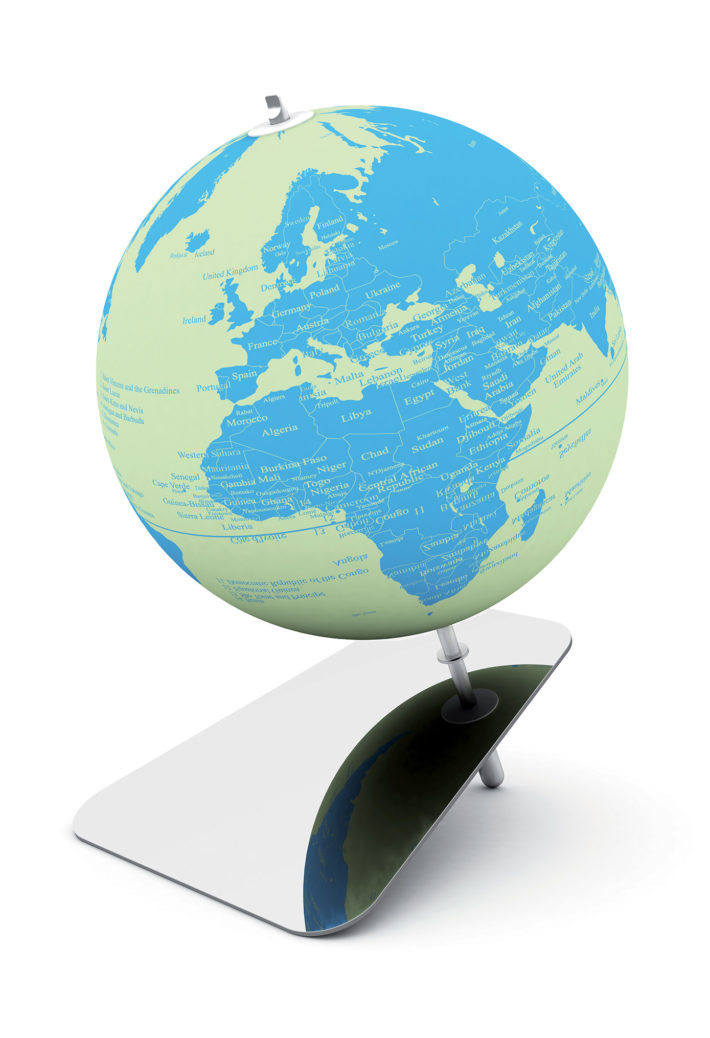
Giulio Iacchetti, Odnom, 2009. Design for Palomar.
In your objects, you express a sense of fun and a lucid vision of what is happening in society. A forceful critical ability that is transformed into an apparent game, and into dissent. How do you cope with this characteristic of yours?
It is a characteristic that has developed over the years: I learned to doubt things, to see order and words in a relative light after a long path of work that was both orderly and disorderly. I am not a born rebel, and I still don’t think I really play that role, but there has been a long process of getting away from the established order. When I arrived at doubt, what at first looked like a condition of uncertainty became, for me, the optimal dimension for the creation of a project. A project is always born in a context of great relativity. We investigate the future and position ourselves as the intermediary between what is shared, established, and what doesn’t exist. The designer places himself between tangible experience and the world to come. I like this indefinite, uncertain space, a space that needs building. I think most of the world’s problems can be attributed to a widespread need for absolute certainty, the assertion of one’s own convictions, the acceptance of established orders. The exhibition at the Triennale, showing those disobedient objects, was one of the most important moments of my reflections about doubt.
Among other things, in that exhibition you showed Odnom (the Italian word for “world” – mondo – spelled back to front, ed), the reversed world map that was then put into production by Palomar.
The map of the globe confronts us with knowledge of the world: it reproduces, on a small scale, a thing on which, in the final analysis, we put our feet on. The globe reproduces the terrestrial sphere. Starting with this scale reproduction, I wanted to draw attention to a strange convention that has taken hold over time: that of the terrestrial coordinates, the concepts of North and South. North above, South below. Parameters that have turned out to be dangerous political and ideological indicators. The North is on top, the South on the bottom.
The South is a part of the world that bears the weight of the North…
Yes, and this is something we cannot afford to overlook. The South has paid, and is paying, for the North of the world. Even the reproduction of such an apparently innocuous object, one that expresses a geographical belief that is, in some respects, quite innocent, can turn out to be a tragic fact. The inclination of the axis in itself makes it hard to see the countries in the Southern Hemisphere. Were the situation reversed, we would be much more familiar with the geography of those countries.
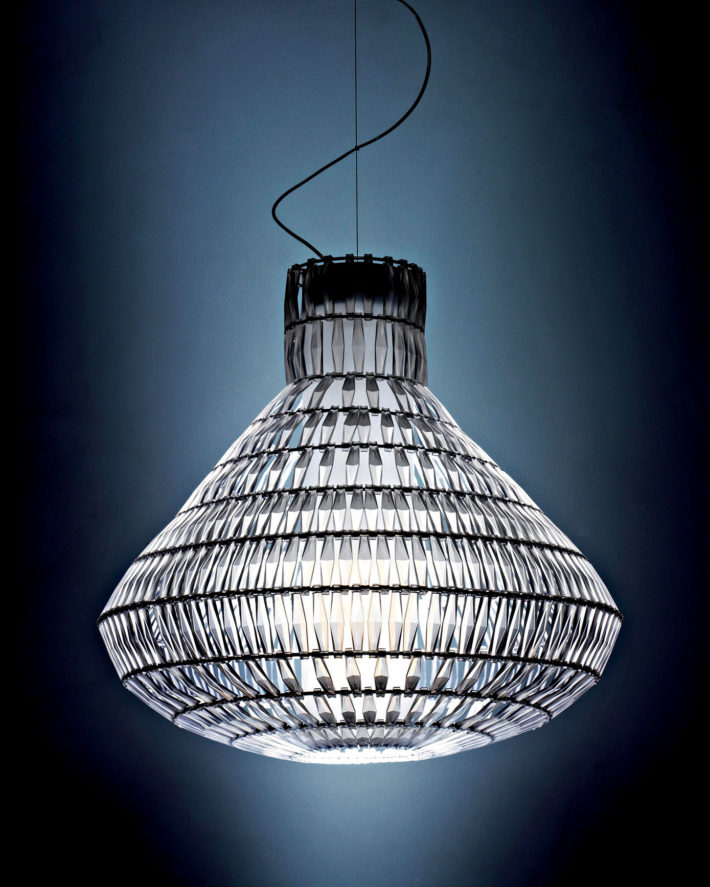
Giulio Iacchetti, Tropico, 2008. Design for Foscarini.
What have you proposed?
I didn’t do much. I didn’t want my intervention to be too personal. I confined myself to placing a mirror underneath, as a base for the globe. In functional terms it is a perfect solution, because the whole globe rests on a point and a line. Thanks to the mirror, I can read the names of the countries in the part that is usually hidden, which are written backwards to make them legible. It’s a simple idea, but it shakes things up. The mirror does not just reflect, but turning the world around, of challenging the established rules, namely that the North should be above and the South below…
A precise, not innocent choice…
Innocent, in the sense that the worst things often happen due to someone’s conviction that they are in the right. You might say that I prefer those who do harm intentionally to those who do harm thinking they are in the right…
What made you decide to start being a designer?
I have always loved forms and objects, especially the simple ones. In my youth I wanted to be a sculptor. To make solid, three-dimensional objects seemed like an experience that would bring boundless self-organizational capacity with it. I had an extraordinary love of sculpture. But then I did not pursue that passion with the discipline and seriousness it required. I did enjoy carving wood, something which I still do today.
Is there one object in particular that fascinated you and made you want to become a designer?
One turning point was a wooden duck. I was at camp, with kids who were smaller than me, and at a market I saw wooden ducks, similar to hunting decoys. I was particularly struck by one duck: it was blue, carved from a block of wood and skillfully painted. It had a smooth, tapered form, as if the duck had just emerged from the water. I bought it on the pretext of giving it to my sister, but then kept it for myself. This duck follows me everywhere, even when I move house and office: it reminds me of my love of forms.
What is an object, in your view?
I often change my definition. Today I think an object has a value in itself, while before I felt as if I had to accompany it with certain adjectives: functional, emotional, poetic, etc. Objects have intrinsic value, they are beautiful, because they have no need of being associated with other things. An object is not more interesting because of its functions, or the emotions it stimulates, or its aesthetic qualities. An object can be released from any quality we want to assign it.
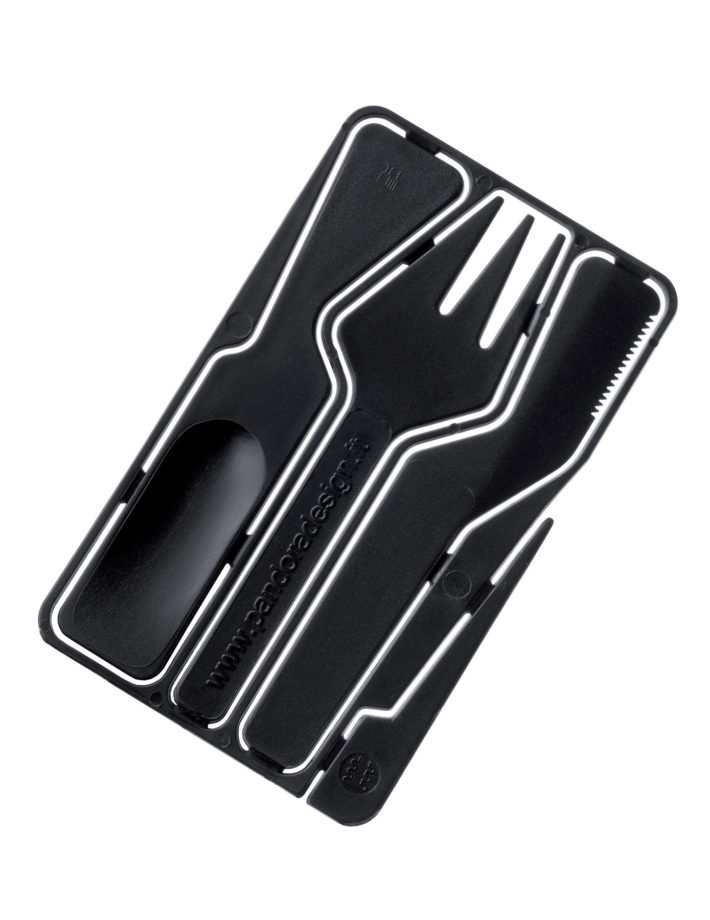
Giulio Iacchetti, Pandora Card, 2004. Design for Pandora Design.
And a design object?
The design object, if we manage to design it well, becomes a life companion for many people. It lasts in time, because it keeps its qualities intact. And this is also true for a single prototype. We have always had a sort of fundamentalist attitude regarding industrial production, which had to be serial, concrete, functional. Now I believe that an object, even if it remains just a prototype, loses nothing of its quality.
How did this idea get started?
Perhaps from a study on sacred objects I am doing right now. I am always reminded of the story of Genesis. An interesting fact: in seven days, God creates the world and then instills his creative faculty into man. It is man who perpetuates this situation. Man generates children and grandchildren, but above all he creates objects and tools.
A task delegated by God…
It is a sort of eighth day that continues infinitely, all the way to our time. The idea that there is a sort of secular sacrality in our work interests me a lot. The functional aspect has its importance, though I always look for the spark of utopia in objects.
Is designing a seat the same as designing any other object?
I’d say so. The object is a medium between us and our idea, an intuition, a doubt. Whatever object it is.
Often designers from the generation prior to yours speak of a design charged with an intention to change and to save the world. What do you think?
I have a different take on that. Design may contribute to fulfill one of the three main categories that lead to quality of life of people: sunlight, religion and beauty. This hypothesis of the three great categories is something I learned about when I was listening to the radio, to a lady, a professor who was commenting on Alice in Wonderland.
Where does the designer come in?
I think with the third element, beauty. A well-designed object, capable of amazing people, of stimulating ideas: this is the contribution we can make. Where religion is concerned, I have trouble thinking of myself as some new sort of guru. As for sunshine, we’re pretty lucky here in Italy.
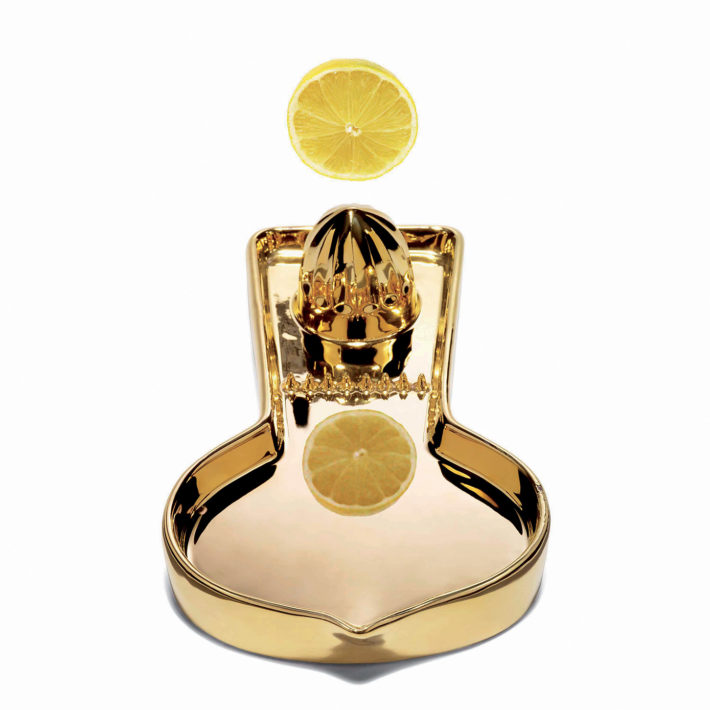
Giulio Iacchetti, St.Peter Squeezer, 2007. Design for Pandora Design.
Which of your objects is the most beautiful?
I always fall in love with the last things I’ve done, or the ones that are about to be launched, because they have all the innocence of something that has not yet been put on the market, though the experimental phase is over. I designed a paper-cutter for Alessi that came from a long process: it evokes the form of a bird and it is made of steel. It has been a thrilling project. With respect to things from the past, perhaps my favorite is the ice cube tray for F.lli Guzzini: the ice cube formed is like an ingot, to remind us that water is a precious resource. But I am too close to too many projects, I can’t really say. I like the ones that are growing.
The critical aspect is strong in the design of the Lingotto.
I like to express a critical viewpoint through a design product. With the Lingotto I suggest reflection on the value of water, but without moralizing. The Lingotto does not force you to use less water, it just produces blocks of ice in the form of gold ingots, instead of the classic cubes. Each ingot has the word GOLD on its smaller surface. A cocktail made with this ice reminds you of something. Those who want to think about it. Those who don’t can just have a drink.
Another project involving critical reflection on water is the Drop shower head, in the form of a drop, produced by IB rubinetterie. How did that get started?
It all starts with irony, because the biggest problem we have in the bath is the faucet or the shower head that drips. This triggers the idea of a shower head in the form of a drop, in soft silicon… The drop shape permits better delivery of the water and prevents the formation of calcium deposits that usually block the holes of shower heads. With a limited amount of water Drop still provides a good spray, and when you’re done showering you can “wring” the head, freeing it of water and deposits. So you consume less water and no longer have problems with calcium.
Among your many works, perhaps the one that more than any other marked a turning point in your career was the Eureka project for Coop. It brought a breath of fresh air to new Italian design.
That was the best experience I have had, in professional terms. It led to friendships, ideas, stimuli. Now I take it for granted that I will see and have fun with Paolo Ulian, Gabriele Pezzini and others. But before that experience we hardly knew each other. We were all a bit diffident, we didn’t want word to get around about what we were working on. It was hard to widen our circle of friends, because we saw each other as competitors. We have always been very reserved about our projects, understandably enough. But this secrecy also wastes lots of energy, and qualities, because discussion is often what leads to the best things. Our great mentors, who were few in number and met with the few entrepreneurs involved in design at the time, all knew each other, followed the same paths, participated in the same competitions, and had opportunities for discussion, critique and self-critique. This wasn’t happening, among those of our generation. At the start we thought about our role, reasoning about utopia, the possibilities we have to make a difference in the society. After the experience with Coop, we held our own gatherings for other types of work, and the encounters became more frequent. A lot has changed. This was what we gained most from the project. Then, the whole aspect of democratic design is well known.

Giulio Iacchetti, Drop, 2008. Design for IB rubinetterie.
Among the objects there were your clothespins, a clothes drying rack, a plunger. All everyday household things. What was the design intention?
To create products for all the families in our country, capable of performing normal functions and designed by a new generation of Italian talents: people who were already known at the time, but not the way they are now. It was also a way of making the presence of a work group, of new names, more authoritative inside the world of design.
What name did you give to your clothespin?
Clothespin. No object had a name. The idea of the clothespin lies in the fact that it is made with just one material. Normally clothespins have multiple materials and are sold as already assembled finished products (plastic slats, metal springs, etc.). This one, on the other hand, is made with just one material and one piece. The mold produces twelve pins, arranged like flower petals around a slender removable plastic disk. The user detaches the individual pins from the disk, eliminating one step that would have to be done in the factory and thus lowering production costs. The disk can also be used as a coaster and the pin, when its life cycle is over, can be thrown away directly in the plastics bin, without the need to separate its parts.
What developments came out of Eureka in the world of large-scale retail trade?
It did not lead to the development we hoped for. It could have opened up a major cycle for large retailers, but that didn’t happen, due to the economic crisis which had a negative impact. When the storm is raging courage can be in short supply, along with the desire to experiment.
You are one of those designers who doesn’t view Ikea with scorn. Why?
It’s easy to criticize Ikea. Ikea has no compunction about taking its inspiration from the best products of Italian and international design. Ikea takes what works and replicates it a lower cost. Actually, there are also products made in an original way. The positive side of Ikea is that it has brought the public into contact with a more refined aesthetic, with less banal products, raising the general level of taste. Ikea is like an elementary school: you can stop there, or you can go on with your schooling, all the way to Driade and Zanotta.
But you can recognize an all-Ikea house…
We shouldn’t be too severe, because that leads to an aristocratic attitude. If only a few people are aware of something we complain, then when many people catch on we turn up our noses… I’d be a little more indulgent.
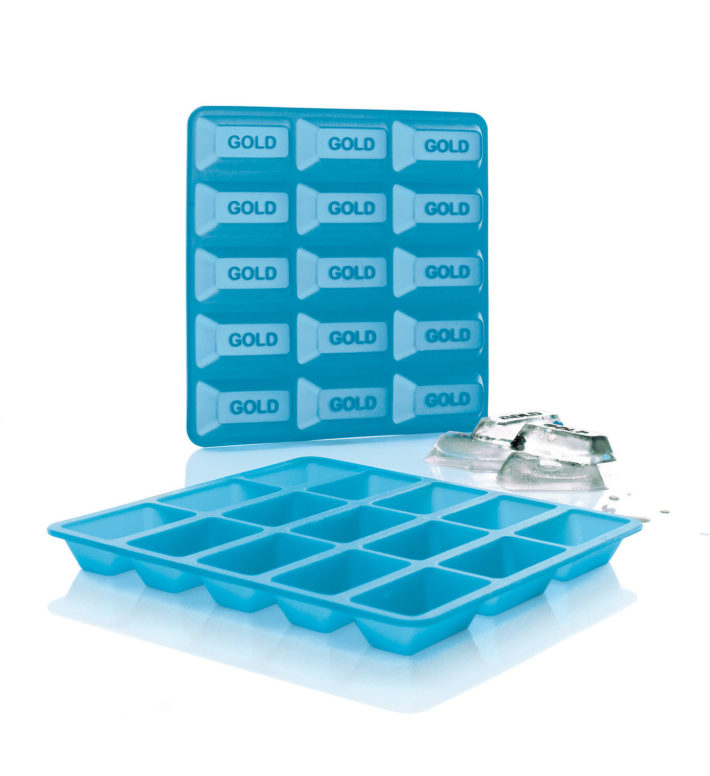
Giulio Iacchetti, Lingotto, 2006. Design for F.lli Guzzini.
From what I’ve seen, in the sixties it was easier to come into contact with design objects. In homes there were often objects created by designers that are now known as great masters.
I’m not so sure. What you are saying was true for metropolitan areas like Milan. Outside the Milanese context, people who were furnishing a home had problems coming into contact with design. As I remember it, in my town, at my house or the homes of my friends, I never saw an object that we regard today as a design classic. But in this area, perhaps, everyone has his own little observatory and can draw his own conclusions. For me, in any case, design was always Milanese.
There are lots of cuckoo clocks in your studio.
I even designed one of them, it was called Silos. It was a tribute to those works of architecture that are used to store fodder in the place I come from. There is a kind of silo called Cremasco that forms the basis of my cuckoo clock, as it echoes its architectural style. I like it very much, though I don’t really know why: when you fall in love you don’t understand the reasons. The history of the cuckoo clock is interesting, from the viewpoint of industrial design and communication. It was invented by a craftsman to promote the Black Forest and the timepieces that were produced in that zone. He combined the two elements. Leaves, hares, pheasants and the little bird that sings, pine cones. A marketing object. The magic of that little bird that pops out… that’s the key to the whole thing.
What is your next project?
I am working a lot with Ceramica Globo, where I am the artistic director. Ceramica Globo produces bath fixtures. I work on projects that explore functional solutions for the bathroom. We recently presented a urinal in the Olivia collection of bath fixtures. It is a urinal for collective spaces that also wants to have a function in the home, to save water and offer an alternative to the second bathroom.
In April your Happy Dice were also released, by Skitsch: after the little armored cars of the TobeUs line, another toy?
It appears that people have played dice since ancient times, even before the invention of writing, and that all the ancient civilizations, starting with the Orient and India, all the way to ancient Greece and Rome, had the same passion for competition and wagers. A deeply rooted thrill, that across the centuries has made it possible to feel Chance, first in your hands, and then to see it roll before your eyes, determining the fate of he who wins and he who loses. So these dice are the contemporary take on an age-old pastime that, with light irony, mocks and defies luck, with a smile. It is also the game of seeing the competition of the six faces grow, one sign at a time, always expressive, always ready to smile.